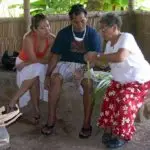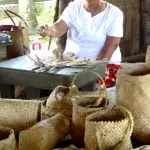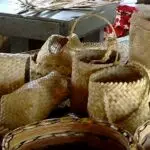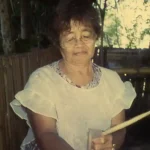Floren Paulino




Master weaver and cultural artist
Floren Meno Paulino (1925 – 2022) was a traditional master weaver, specializing in plaiting coconut palm and pandanus leaves into utilitarian and decorative items. She demonstrated her skills at the Gef Pa’go Cultural Village in Inalåhan, Guam for many years.
Paulino was born in 1925 to Juan and Patrona C. Meno. She was raised in the southern village of Inalåhan along with her siblings in what is now one of the historic properties recently rehabilitated by the Guam Preservation Trust.
For Paulino, the memories of her youth ran deep—of the original one-story wooden house, raised three feet above the ground on wooden poles, where she remembered competing with neighboring girls to complete her designated chore—preparing corn titiyas (tortillas) for the family. Life in pre-War Guam was different than today. Many families lived in wood houses, slept on woven mats laid out on the floor, and relied on other woven items such as different sized baskets, mats and hats for various day-to-day activities.
Growing up, Paulino learned the basic skills of weaving from her father. By the age of 12, she was already crafting both useful and practical items, including guagua’ nengkanno’ (food baskets) and tuhong siha (hats). These articles were usually woven from the new or young, soft leaves, called binga, of the coconut palm tree. She continued increasing her skills with knowledge shared from other family members and friends, sometimes learning different things while at school. She soon became proficient enough to weave decorative items, such as paluma (birds), uhang (shrimp), adothon ulu (head bands) and inareklan flores (floral arrangements). In addition, she began learning how to weave with the harder, sturdier pandanus leaves.
The leaves of the pandanus plant (Pandanus tectorius, or akgak in CHamoru/Chamorro), which is indigenous to Guam, are more difficult to work with and need to be processed before they can be plaited or woven together. The leaves have thorns or spines which must be stripped off, and then the leaves must be rolled, boiled, and then allowed to dry for several days before they can be worked.
Paulino has described how this process is hard work and takes time, but this is how it has been done for generations, and the result is a soft, pliable fiber that is easy to weave. In addition, the longer the leaf is dried in the sun, the whiter it gets. After this preparation, the pandanus leaves can then be fashioned into different shaped baskets, bags, all kinds of table mats and other items, often decorated with elaborate designs by combining different shaded leaves.
Paulino continued the tradition of weaving through her work at the Gef Pa’go Cultural Village, where she demonstrated and taught traditional weaving methods and articles for tourists, guests and student visitors to the site. She also participated in numerous cultural events throughout the years all over the island and throughout the region. She received formal recognition as a Master Weaver by the Guam Council on the Arts and Humanities Agency (CAHA) in 1997 as part of the Masters of CHamoru Tradition poster series.
For further reading
Flores, Judy, and Rosanna Barcinas. Groundbreaking Ceremony February 1, 2011, Juan and Patrona C. Meno House (L67, Inalahan). Hagåtña: Guam Preservation Trust (GPT), 2011.
Guam Council on the Arts and Humanities Agency. “Artists Directory.”
Herman, RDK. “Guam: Inarajan – Our Guides.” Pacific Worlds, 2003.
Leon Guerrero, Jesse. “Chamorros weave for art and culture.” Joint Region Edge.
“Master Weaver Tan Floren Meno Paulino.” In A Journey with the Masters of Chamorro Tradition. Hagåtña: CAHA, 2000.
